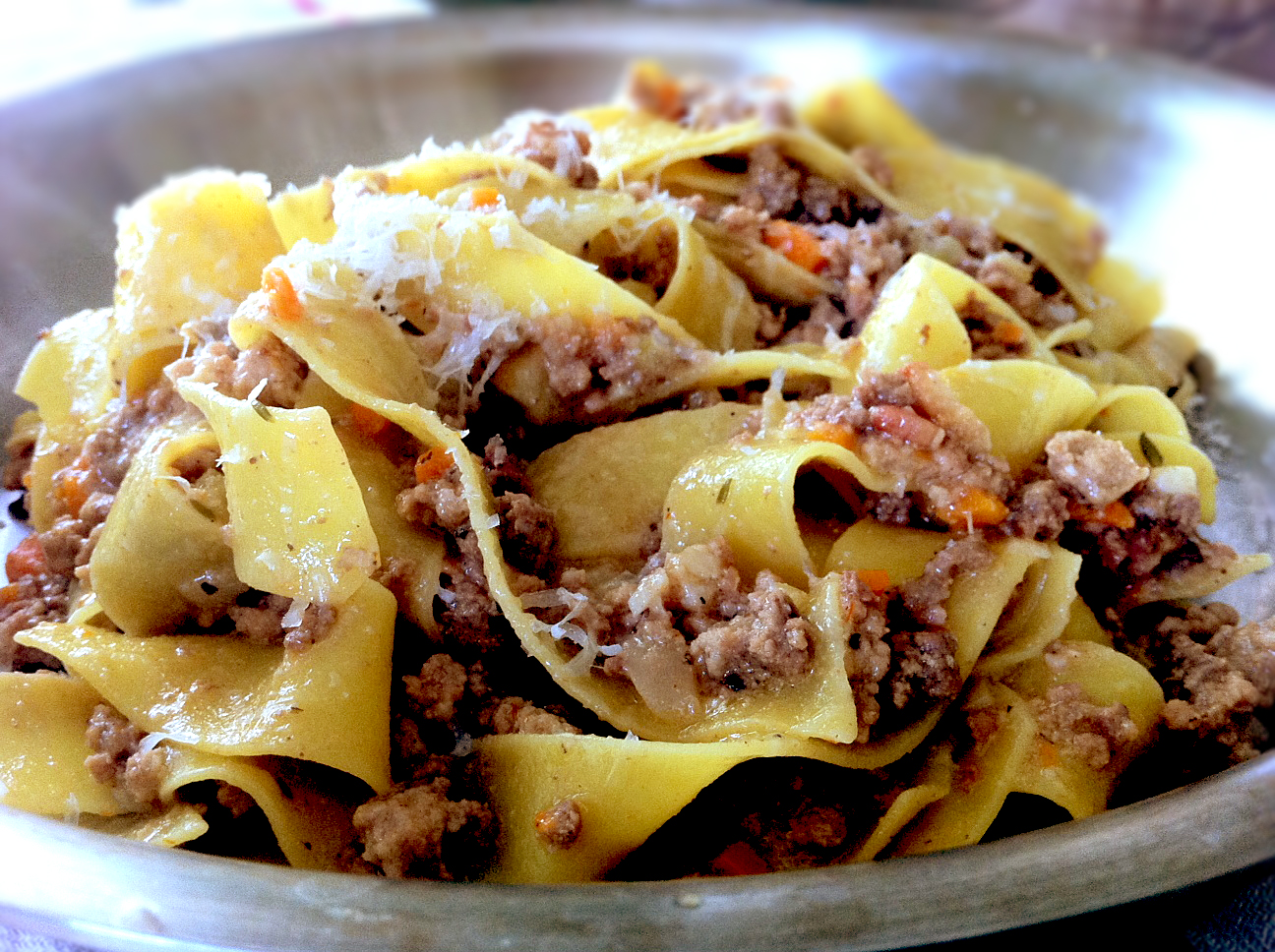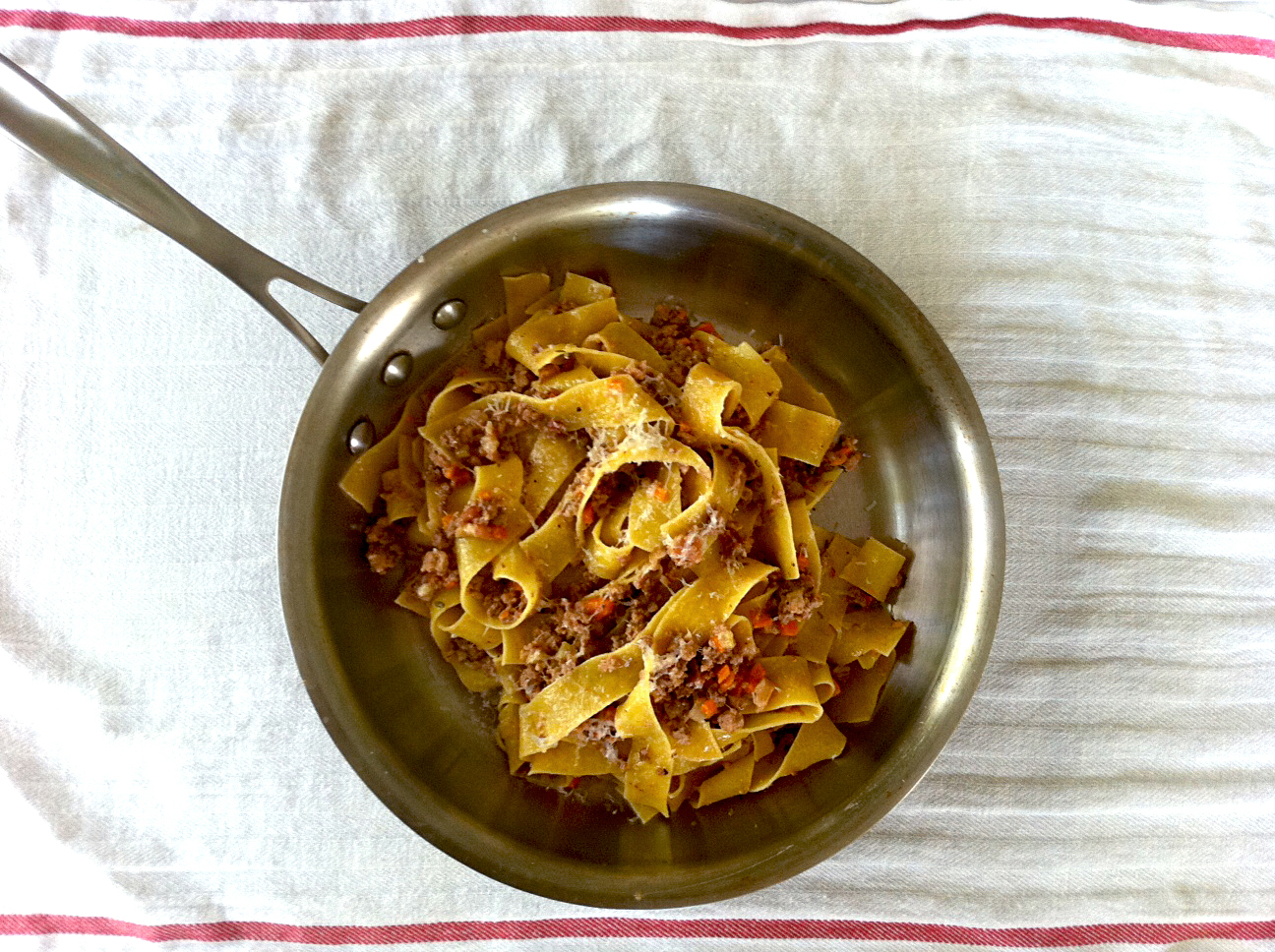IT’S NOT A MEAL, IT’S A COMMENTARY ON YOUR FAMILY HISTORY
I’ve mentioned “Any asshole knows…” a time or two before. It was one of my Grandfather’s favorite chestnuts, usually followed by “you don’t [insert whatever stupid or wrong act someone committed here].” The point being that even an asshole, or someone lacking in intelligence, knows better than to do what you just did. He was a man of strong opinions, and he said it a lot. Now, as an adult, I say it a lot. Funny how that works.
In addition to joining “Don’t be a dumb sonofabitch” on the pantheon of great wisdom to live by, it’s a particularly appropriate sentiment when speaking of ragu Bolognese. Or more accurately, someone else’s interpretation of it. As in, “Any asshole knows you don’t put veal in it, it’s about the beef.” Or “Any asshole knows you don’t put Bolognese on spaghetti, where’s your tagliatelle?” Or “Any asshole knows you gotta get some porcini in there when you add the milk.” Or “Any asshole knows… wait, what is this? A joke? Go back to the Rhine or Utah or wherever it is that this crap passes for Bolognese sauce, you mamaluke.”
There’s some things that you just don’t screw with and ragu Bolognese is one of them. Food is a serious matter, and Bolognese is about as old school serious as you can get.
First appearing back around the fifth century, Bolognese predates the tomato in Italian cooking. In all likelihood it was simmering in a few Italian kitchens as the Germanic barbarian hoards poured across the border and ruined the glory of ancient Rome (which is probably why my Teutonic-blooded wife loves it so much, her people developed a taste for quality Italian food early).
It’s the very ancient nature of the sauce that gives its unique insight into history. If your family’s recipe uses only milk and wine, it’s from before Columbus “discovered” the New World, screwing over countless indigenous people and bringing the tomato home to Italy in the process (a worthy trade or not, depending on who you ask). If your Bolognese has some tomato in it, yours is a post 1492 recipe. And if your Bolognese looks like a sloppy joe with some store brand Italian seasoning sprinkled throughout, you’re most likely a 4th generation lunch lady and you should stop reading right now—you don’t deserve to learn this in light of the atrocities you’ve committed in the name of this noble ragu.
Ragu Bolognese is dogmatic to be sure. But like anything that’ s been around long enough, that dogma seems entirely dependent on who’s dictating it. I’ve heard countless subtle variations, all from friends and chefs who know food. All apparently authentic, if slightly different. All 100% sure that theirs is the one true legitimate heir to the intent of the original recipe conceived so long ago.
Paul Bertolli calls for mostly beef and goes into lengthy dissertations about which cut, properly ground, makes the best sauce. Some of Mario Batali’s preparations eschew beef entirely opting for a mixture of pork and veal simmered in milk. A chef I used to work for simmers the soffritto and meat in a mixed meat stock and tomato puree, adding only a small amount of cream at the end of cooking. One friend includes finely diced sopressata. While another, who’s family recipe is no doubt legit, insists that you must include porcini and a small amount of nutmeg. The one thing that they all seem to agree on is that everybody else’s recipe isn’t nearly as good, and in some cases just flat out wrong or even insulting.
After various experiments with recipes and meat combinations I’ve settled on what I find to be the best balance of ground critter, aromatics and liquids. I like to use a mixture of grassfed beef and home cured pancetta, simmering it with thyme, soffritto and a little bit of tomato paste in a mixture of white wine and milk. I also like to serve mine with papparadelle instead of the more traditional tagliatelle, mostly because my wife loves the really wide noodles and this is one of her favorite meals. This may not be the most definitive Bolognese recipe, but it’s the definitive one on my table. And in my family, any asshole knows that’s the only one that really matters.
Papparadelle Bolognese
2lbs grass fed beef, ground
1/3 lb diced pancetta (home cured is best)
1 red onion, diced
2 carrots, diced
2 celery stalks, diced
2 garlic cloves, chopped
A few tablespoons of tomato paste
2 cups whole milk
2 cups dry white wine
several sprigs worth of thyme leaves
Salt and pepper
Olive Oil
Homemade Papparadelle (DeCecco makes a nice one if you’re feeling lazy, which I do sometimes)
Parmigiano Reggiano
In a large sauce pan heat a little olive oil and add the pancetta, cooking till it starts to render. Add the ground beef and brown over high heat, making sure to mash the beef with a spatula, making it as fine a texture as possible. Season and brown it very, very thoroughly. Remove it to a plate and throw in your soffritto (celery, carrot, onion, garlic) and brown it in the rendered fat. Once it has browned slightly, season with salt and pepper and continue to sweat, scraping up any browned bits from the bottom of the pan. Throw in your tomato paste and brown, till the pan is rust colored. Pour in the wine, then the milk, scrape the bottom again and bring to a simmer. Add your browned meats and ½ of your thyme leaves. Simmer for about 2 hours, adding a little water if necessary when the sauce gets too dry. When the flavors have melded and the meats are tender, add the remaining thyme. This recipe makes a good amount of ragu, so you may want to reserve some of it before mixing in your pasta, oil and cheese. Boil your pasta till not quite al dente and mix with the ragu over high heat. Then turn off the flame and add your cheese and olive oil. Enjoy and keep your eye on any suspicious German neighbors encroaching on your lawn.
Homemade Papparadelle
3 large eggs
2 egg yolks
Pinch salt
Drizzle olive oil and water
3 cups, plus, Tipo 00 flour
On a board, make a well with the flour. Put all other ingredients in the well and mix together thoroughly. Gradually incorporate all the flour. Scrape and flour your board then need for 10-15 minutes, till you have a slightly sticky but smooth dough. Cover with plastic wrap and rest it for an hour. Roll your pasta out to its thinnest setting on a pasta machine (if you’re using a rolling pin, first you’ll have arms like Lou Ferrigno by the time you’re done, and second roll in batches till you can see the grain of your board through the pasta). Let the sheets dry slightly then roll them and cut them in 1 inch widths, so you end up with long, inch-wide strips. Boil in plenty of heavily salted water till just before done (a minute or two, when it begins to float). Mix with sauce over high heat, till pasta is al dente. Garnish with olive oil and cheese.
*To make tagliatelle, the more authentic shape for the Bolognese sauce, cut the pasta in about 1/4 inch wide strips.



You are a master of words and of the culinary arts. I raise a glass (and fork) to your cooking prowess.
I love good food. But I’m a lazy cook always looking for a short cut. Anyway you could bottle this up? Now I’m hungry. Damn.
Robert: Thanks man… I’m blushing under my beard.
Ella: There are some things like farts, love and this Bolognese sauce that just can’t be bottled. You should try making this, it’s mostly passive time spent watching football and having a beer while the sauce perks away.
Mmm I want!
that lunch lady comment cracked me up. this looks delicious!
Thanks Teresa
I’m waiting for some hate mail from somebody along the lines of “My mother was a lunch lady…”
great blog – will stop by again. and i am in love with your grandfather. anyone whose “chestnuts” involve the word asshole has got my seal of approval!
Thanks for checking it out.
My Grandfather was great– a former sailor, minor and cinder block maker. He had a great mix of cursing in Italian and English to get his point across, he was also one hell of a cook.
Also, I checked out your site. Looks great!